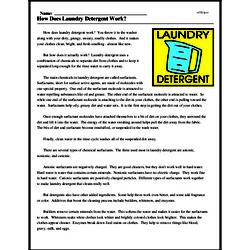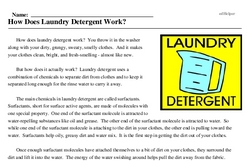How Does Laundry Detergent Work?
How does laundry detergent work? You throw it in the washer along with your dirty, grungy, sweaty, smelly clothes. And it makes your clothes clean, bright, and fresh-smelling - almost like new.
But how does it actually work? Laundry detergent uses a combination of chemicals to separate dirt from clothes and to keep it separated long enough for the rinse water to carry it away.
The main chemicals in laundry detergent are called surfactants. Surfactants, short for surface active agents, are made of molecules with one special property. One end of the surfactant molecule is attracted to water-repelling substances like oil and grease. The other end of the surfactant molecule is attracted to water. So while one end of the surfactant molecule is attaching to the dirt in your clothes, the other end is pulling toward the water. Surfactants help oily, greasy dirt and water mix. It is the first step in getting the dirt out of your clothes.
Once enough surfactant molecules have attached themselves to a bit of dirt on your clothes, they surround the dirt and lift it into the water. The energy of the water swishing around helps pull the dirt away from the fabric. The bits of dirt and surfactant become emulsified, or suspended in the wash water.
Finally, clean water in the rinse cycle washes all of the suspended dirt away.




